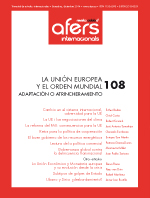Líbano y Siria: entre la disociación y el desbordamiento
Palabras clave:
Líbano, Siria, conflicto civil, confesionalismo, desbordamientoResumen
Revista CIDOB d’Afers Internacionals, nº 108
Cuatrimestral (septiembre-diciembre 2014)
ISSN:1133-6595 | E-ISSN:2013-035X
La guerra civil siria supone un elevado riesgo de extensión de la violencia distintos factores tanto derivados del conflicto vecino como por otros existentes en la política libanesa. Esto ha conducido a una fuerte colaboración del Movimiento de Futuro de la familia Hariri y de Hezbolá con sus respectivos aliados en Siria, hecho que ha minado la política de disociación del anterior primer ministro libanés Najib Mikati. Sin embargo, los dirigentes de estos partidos tienden a equilibrar su voluntad de conservar su liderazgo confesional con una imagen de defensores de los intereses nacionales. Ello limita la posibilidad de un conflicto abiertamente sectario, aunque no la elimina totalmente.
Citas
Al-Fakih, Ranan y Khraiche, Dana. «Nusra Branch Says Hermel Blast Response To Hezbollah in Syria». The Daily Star (17.01.2014) (en línea) [Fecha de consulta 20.01.2014] http://www.dailystar.com.lb/News/LebanonNews/2014/Jan-17/244320-nusra-branch-says-hermel-blast-response-tohezbollah-in-syria.ashx
Barnes-Dacey, Julien. «Lebanon: Containing Spillover from Syria». European Council on Foreign Relations, Policy Brief, n.º 61 (diciembre de 2012).
Berti, Benedetta. «Tensions in Tripoli: The Syrian Crisis and its Impact on Lebanon». INSS Insight, n.º 336 (20.05.2012) (en línea) [Fecha de consulta 09.03.2013] http://www.inss.org.il/index.aspx?id=4538&articleid=2485
Biondi, Charles Brian. «The Impact of the Syrian Crisis on Lebanon. Local and Regional Rationales for Hezbollah’s Involvement in Syria». IAI Working Papers, n.º 13 (31.10.2013).
Black, Nathan W. The Spread of Violent Civil Conflict: Rare, State-Driven and Preventable. Tesis doctoral. Boston: Instituto Tecnológico de Massachussets, 2012.
Buhaug, Halvard, et al. «Geography, Rebel Capability, and the Duration of Civil Conflict». Journal of Conflict Resolution, vol. 53, n.º 4 (2009), p. 544- 569.
Chaitani, Youssef. Post-Colonial Syria and Lebanon. The Decline of Arab Nationalism and the Triumph of the State. Londres: I.B. Tauris, 2007.
Chemaly, Rita. Le Printemps 2005 au Liban. Entre mythes et réalités. Paris: L’Harmattan, 2009.
Christophersen, Mona; Liu, Jing; Thorleifsson, C.M. y Tiltnes, Age A. «Lebanese Attitudes Towards Syrian Refugees and the Syrian Crisis. Results from a National Opinion Poll». FAFO Paper, n.º 13 (2013) (en línea) [Fecha de consulta 20.01.2014] http://www.fafo.no/pub/rapp/10179/10179.pdf
Chulov, Martin. «Syria Conflict Pits Shia Against Sunni As Hezbollah Says This Is ´War We Must Win`». The Guardian (01.01.2014) (en línea) [Fecha de consulta 05.01.2014] http://www.theguardian.com/world/2014/jan/01/syria-shia-sunni-hezbollah-war
Corbeil, Alexander. «The Syrian Conflict and Sunni Radicalism in Lebanon». (09.01.2014) (en línea) [Fecha de consulta 12.01.2014] http://carnegieendowment.org/sada/2014/01/09/syrian-conflict-and-sunni-radicalism-inlebanon/gxw8
Dakroub, Hussein. «Cabinet Formed. Salam´s Real Work Begins». The Daily Star (17.02.2014) (en línea) [Fecha de consulta 19.02.2014] http://www.dailystar.com.lb/News/Lebanon-News/2014/Feb-17/247577-cabinet-formed-salams-real-work-begins.ashx#ixzz2u3Oz8AIU
Dakroub, Hussein y Lakkis, Hassan. «Ministers Seek Unified Formula on Resistance». The Daily Star (22.02.2014) (en línea) [Fecha de consulta 23.02.2014] http://www.dailystar.com.lb/News/Lebanon-News/2014/Feb22/248146-ministers-seek-unified-formula-on-resistance.ashx
Dehghanpisheh, Babak. «In Lebanon, Kidnapping By Clans Raise Alarm». The Washington Post (25.08.01) (en línea) http://www.washingtonpost.com/world/middle_east/in-lebanon-kidnappings-by-clans-raise-alarm/2012/08/24/e1702bb2-ee17-11e1-afd8-097e90f99d05_story.html
Dekel, Udi y Perlov, Orit. «The Saudi Arabia and Kuwait “Outsposts Project”: Al Qaeda and Its Affiliates». INSS Insight, n.º 517 (16.02.2014) (en línea) [Fecha de consulta 20.02.2014] http://www.inss.org.il/index.aspx?id=4538&articleid=6608
Development Management International. «Rapid Assessment of the Impact of the Syrian Crisis on Socio-Economic Situation in Bekaa and the North» (agosto de 2012) (en línea) [Fecha de consulta 05.10.2013] www.data.unhcr.org/syrianrefugees/download.php?id=957
Doar, Kira y Krauss, Joseph. «Return to Fatahland? Syria´s Refugees in Lebanon´s Conflict». IMES Capstone Paper Series, George Washington University (abril de 2013) (en línea) [Fecha de consulta 12.10.2013] https://www.gwu.edu/~imes/assets/docs/Capstone%20Papers%20-%202013/Capstone_Doar%20and%20Krauss.pdf
Fearon, James y Laitin, David. «Ethnicity, Insurgency and Civil War». American Political Science Review, vol. 97, n.º 1 (2003), p. 75-90.
Gambill, Gary. «Syria´s Triumph in Lebanon: Au Revoir les Ententes». MERIA, vol. 14, n.º 4 (2010), p. 26-46.
Gurr, Ted. «Ethnic Warfare on the Wane». Foreign Affairs, vol. 79 n.º 3 (2000), p. 52-64.
Heras, Nicholas A. «A Particular Province of Syria: An Eye on the Akkar». Fair Observer (12.07.2012) (en línea) [Fecha de consulta 20.12.2013] http://www.fairobserver.com/article/particular-province-syria-eye-akkar
International Crisis Group. «Too Close for Comfort: Syrians in Lebanon». Middle East Report, n.º 141 (2013) (en línea) [Fecha de consulta 02.12.2013] http://www.crisisgroup.org/~/media/Files/Middle%20East%20North%20Africa/Iraq%20Syria%20Lebanon/Lebanon/141-too-close-for-comfortsyrians-in-lebanon.pdf
International Crisis Group. «A Precarious Balancing Act: Lebanon and the Syrian Conflict». Middle East Report, n.º 132 (2012) (en línea) [Fecha de consulta 20.01.2013] http://www.crisisgroup.org/~/media/Files/Middle%20East%20North%20Africa/Iraq%20Syria%20Lebanon/Lebanon/132-a-precarious-balancing-act-lebanon-and-the-syrian-conflict
International Crisis Group. «Lebanon´s Politics: The Sunni Community and Hariri´s Future Current». Middle East Report, n.º 96 (2010) (en línea) [Fecha de consulta 14.10.2013] http://www.crisisgroup.org/~/media/Files/Middle%20East%20North%20Africa/Iraq%20Syria%20Lebanon/Lebanon/96%20Lebanons%20Politics%20%20The%20Sunni%20Community%20and%20Hariris%20Future%20Current.ashx
Karouny, Mariam. «Syrian Forces Re-Take Town in Qalamoun Region». Reuters (29.11.2013) (en línea) [Fecha de consulta 08.12.2013] http://www.reuters.com/article/2013/11/29/us-syria-crisis-idUSBRE9AS0CP20131129
Lake, David y Rothchild, Donald. «Spreading Fear: The Genesis of Transnational Ethnic Conflict», en: Lake, David y Rothchild, Donald (eds.) The International Spread of Ethnic Conflict. Princeton: Princeton University Press, 1998, p. 3-23.
Leenders, Reinoud. «“Regional Conflict Formations”: Is the Middle East Next?». Third World Quarterly, vol. 28, n.º 5 (2007), p. 959-982.
Leigh, Karen. «State of the Battle: Fighting Tooth and Nail for Qalamoun». Syria Deeply (05.12.2013) (en línea) [Fecha de consulta 06.01.2014] http://beta.syriadeeply.org/2013/12/state-battle-fighting-tooth-nail-qalamoun/#.UvZq82J5OSo
Leverett, Flynt. Inheriting Syria: Bashar´s Trial by Fire. Washington D.C.: The Brookings Institution, 2005.
Mourtada, Hania. «Sunni Leader Is Named Prime Minister in Lebanon». The New York Times (06.04.2013).
Murdoch, James M. y Sandler, Todd. «Economic Growth, Civil Wars, and Spatial Spillovers». Journal of Conflict Resolution, vol. 46, n.º 1 (2002), p. 91-110.
Nasr, Vali. The Shia Revival. How Conflicts Within Islam Will Shape the Future. Nueva York: WW Norton & Co., 2006.
Nassief, Isabel. «Hezbollah and the Fight for Control in Qalamoun». Institute for the Study of War (26.11.2013), (en línea) [Fecha de consulta 04.01.2014] http://www.understandingwar.org/backgrounder/hezbollahand-qalamoun
National Dialogue Committee. «Baabda Declaration» A/66/849–S/2012/477, (11.06.2012), (en línea) [Fecha de consulta 12.11.2013] http://www.securitycouncilreport.org/atf/cf/%7B65BFCF9B-6D27-4E9C-8CD3-CF6E4FF96FF9%7D/Lebanon%20S%202012%20477.pdf
Nerguizian, Aran. «The Lebanese Armed Forces». CSIS Paper (2009) (en línea) [Fecha de consulta 22.11.2013] http://csis.org/files/media/csis/pubs/090210_lafsecurity.pdf
Norton, Augustus Richard. «Lebanon After Ta´if: Is the Civil War Over?». Middle East Journal, vol. 45, n.º 3 (1991), p. 457-473.Ouahes, Idir y Smith, Ben. «The Deal With Iran». SNIA6780, House of Commons Library, 13.12.2013 (en línea) [Fecha de consulta 23.01.2014] www.parliament.uk/briefing-papers/sn06780.pdf
Rabinovich, Itamar. «The Changing of the Tide in the Syrian Civil War». INSS Insight, n.º 499 (17.12.2013) (en línea) [Fecha de consulta 05.01.2014] http://d26e8pvoto2x3r.cloudfront.net/uploadImages/systemFiles/No.%20499%20-%20Itamar%20for%20web038091879.pdf
Rifi, Gassan. «Chaos Reigns in North Lebanon, Where Military Has Lost Control». Al Monitor (15.06.2012) (en línea) [Fecha de consulta 20.06.2012] http://www.almonitor.com/pulse/politics/2012/06/is-the-army-testing-the-declarat.html
Ryan, Curtis. «The New Arab Cold War and the Struggle for Syria». MERIP, vol. 42, n.º 262 (2012) (en línea) [Fecha de consulta 04.02.2013] http://www.merip.org/mer/mer262/new-arab-cold-war-struggle-syria
Salamey, Imad. «Failing Consociationalism in Lebanon and Integrative Options». International Journal of Peace Studies, vol. 14, n.º 2 (2009), p. 83-105.
Salehian, Idean. «No Shelter Here: Rebel Sanctuaries and International Conflict». Journal of Politics, vol. 70, n.º 1 (2008), p. 54-66.
Salehian, Idean y Skrede Gleditsch, Kristian. «Refugees and the Spread of Civil War». International Organization, vol. 60 (2006), p. 335-366.
Salem, Paul. «Can Lebanon Survive the Syrian Crisis?». The Carnegie Papers (diciembre de 2012) (en línea) [Fecha de consulta 09.01.2013] http://carnegieendowment.org/files/lebanon_syrian_crisis.pdf
Saouli, Adham. «Stability Under Late State Formation: The Case of Lebanon». Cambridge Review of International Affairs, vol. 19, n.º 4 (2006), p. 701-717.
Seale, Patrick. Asad of Syria. The Struggle for the Middle East. Berkeley y Los Angeles: University of California Press, 1995.
Väyrynen, Raimo. «Regional Conflict Formations: An Intractable Problem of International Relations». Journal of Peace Research, vol. 21, n.º 4 (1984), p. 337-359.
Vloeberghs, Ward. «The Hariri Political Dynasty after the Arab Spring». Mediterranean Politics, vol. 17, n.º 2 (2012), p. 241-248.
Weiner, Myron. «Bad Neighbors, Bad Neighborhoods: An Inquiry into the Causes of Refugee Flows». International Security, vol. 21, n.º 1 (1996), p. 5-42.
Winslow, Charles. Lebanon: War and Politics in a Fragmented Society. Londres: Routledge, 1996.
Young, Michael. «Toward Conflict or Concord in Beyrut?». The Daily Star (20.02.2014) (en línea) [Fecha de consulta 24.02.2014] http://www.dailystar.com.lb/Opinion/Columnist/2014/Feb-20/247872-toward-conflict-orconcord-in-beirut.ashx#axzz2vSdCbw27
Young, Michael. «In Tripoli, A Conflict Exploited by All». The Daily Star (5.12.2013) (en línea) [Fecha de consulta 08.12.2013] http://www.dailystar.com.lb/Opinion/Columnist/2013/Dec-05/239935-in-tripoli-a-conflictexploited-by-all.ashx#axzz2vSdCbw27
Zisser, Eyal. «Hizballah in Lebanon: Between Tehran and Beirut, Between the Struggle with Israel and the Struggle for Lebanon», en: Rubin, Barry (ed.) Lebanon. Liberation, Conflict and Crisis. Nueva York: Palgrave-Macmillan, 2009, p. 155-176.













